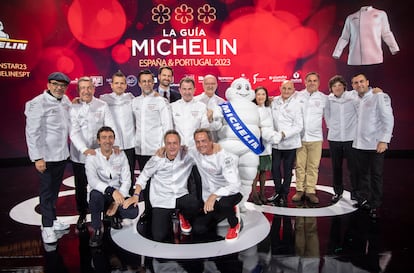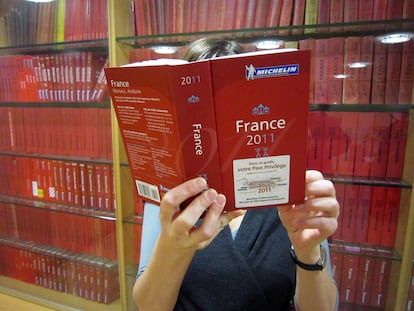How to cook up a Michelin star
A study by the University of Seville analyzes the geographical and socioeconomic variables that favor the ranking of excellent restaurants

On November 28, the Michelin Gala was held in Spain, illuminating the restaurant scene with the news stars that the French guide distributes each year. A Michelin star doesn’t only highlight excellent cuisine: it also serves to promote local gastronomy, which can bolster the economic development of an area. Sometimes, the recognition can become a catalyst for culinary tourism.
Taking into account the impact of such an award, many would like to have the recipe for a Michelin star on hand, so that they can cook one up in their city or town. In fact, the applied economics & management research group at the University of Seville has carried out a study to determine this magic formula. The research was published this past summer in The International Journal of Gastronomy and Food Science. The article — Towards a Sky Full of Michelin Stars — discusses which variables determine the ability to obtain said award.
Not every restaurant is a potential winner, in the same way that not every person — no matter what positive thinking tells us — is a potential sports star. This isn’t like the lottery, where the more tickets you have, the more likely you are to win. “There are certain specific ecosystems that generate great restaurants, [in the eyes of] the culinary elite,” explains José Ignacio Castillo, a professor of economics and co-author of the report alongside Dr. Álvaro Zarzoso. And, in those specific ecosystems that Castillo alludes to, there are several factors that, according to the econometric methodology used, contribute to the appearance of Michelin stars.
Firstly, international tourism is key. Secondly, the luxury sector operates as a virtuous circle: three-star Michelin restaurants are usually established in luxury hotels. However (and this is the third factor) many restaurants with that rating also attract attention in more modest settings by highlighting the local origin of their products. On top of all of this, lots of market research and development is essential.
The study focuses exclusively on Spain and the pre-Covid period, from 2000 to 2019. “A stage of ‘Michelinization’ of the Spanish hospitality sector,” Castillo chuckles. The professor points out how, during those two decades, the number of Michelin-starred restaurants in Spain grew from 92 to 207… a growth of 125% that has reached 43 of Spain’s 52 provinces. At the beginning of the 21st century, only 23 provinces in Spain could claim a Michelin-starred establishment.
The researchers have taken geographical and socioeconomic variables into consideration, such as the weight of both national and foreign tourism, based on the understanding that Michelin stars attract tourists and that tourists are also more likely to seek out these restaurants. The per capita income of each province was also analyzed, to determine if there’s a relationship between restaurants with three Michelin stars and the income level of the population. The relationship with the primary sector — agricultural, livestock and fishing products — the industrial sector and construction has also been studied, based on the hypothesis that the more weight these sectors had, the greater demand could be generated to dine at these restaurants. Finally, the criteria of the Michelin Guide inspectors (who award the stars) have been taken into account: the choice and quality of the ingredients, culinary techniques and creativity, the regularity and consistency of the establishment, as well as the experience it offers to diners.
After cooking all these variables and adding the algorithmic methodology — after dividing up the establishments with one, two and three Michelin stars, looking at numbers of tourists and types of tourism (beach, cultural and business), accounting for the number of restaurants and cooking schools per capita, and considering the origins of produce and even the temperature — it was finally concluded that the appearance and maintenance of these restaurants is influenced by the potential volume of international clients, rather than local ones. “However, there’s no significant relationship with national tourists or with the income level of the local population,” Castillo notes. “This explains why in Cáceres or Cádiz — [municipalities] with low income levels, but a large influx of tourism — there are two-star and three-star Michelin restaurants,” he explains.
This implies that it’s not necessary to be a wealthy region in order to have excellent cuisine… although Michelin restaurants do tend to be tied to luxury. “There’s a two-way relationship: a five-star hotel ends up being an optimal location for Michelin-starred establishments, such as the hotel designed by Frank Gehery for the Marqués de Riscal wineries [in the Basque Country]... but, at the same time, these restaurants, in turn, can attract luxury hotels,” Castillo points out. He mentions the Spanish city of Cáceres, where the Michelin-starred restaurant Atrio attracted the attention of luxury hotel chain Relais & Châteaux, which set up a boutique hotel as part of the establishment.
Another conclusion that emerges is that “quality is above quantity.” The mere fact of having several hospitality schools in an area doesn’t guarantee the appearance of a Michelin-starred restaurant, nor does the specific weight of the primary sector in the local economy boost chances. “The proximity of [quality produce] and a high level of market research having been done in the area are more important.” Likewise — and paradoxically — the economic importance of industry or construction may have more impact than the agri-food sector. “A lot of agriculture doesn’t contribute to generating Michelin stars, but large companies will need high-quality local services for events, or to be able to close an important deal. It’s not a coincidence that, when the real estate bubble burst, many luxury restaurants also closed,” Castillo explains.
Hospitality schools aren’t a determining factor, either. This is because many of the students later return to their places of origin. What the study has shown is that Michelin-starred restaurants themselves are the best breeding ground for creating new chefs: they end up attracting their own talent. “Here lies the debate [that arose during the period of study] about whether those who worked in these restaurants were paid too little and were being exploited, or if they were actually receiving exceptional and unique training, equal to or better than in hospitality schools,” Castillo says.
And here lies another of the study’s conclusions: the relationship between Michelin-starred restaurants and their local areas feed off of each other. In addition to offering excellent training, the chefs who work at these establishments are the best ambassadors to leverage a city or region as a tourist destination. The study offers the NATO summit that was held in Madrid last year as an example: much prominence was given to chefs José Andrés and Paco Roncero at the Prado Museum dinner, which was held for the leaders of member nations.
Sign up for our weekly newsletter to get more English-language news coverage from EL PAÍS USA Edition
Tu suscripción se está usando en otro dispositivo
¿Quieres añadir otro usuario a tu suscripción?
Si continúas leyendo en este dispositivo, no se podrá leer en el otro.
FlechaTu suscripción se está usando en otro dispositivo y solo puedes acceder a EL PAÍS desde un dispositivo a la vez.
Si quieres compartir tu cuenta, cambia tu suscripción a la modalidad Premium, así podrás añadir otro usuario. Cada uno accederá con su propia cuenta de email, lo que os permitirá personalizar vuestra experiencia en EL PAÍS.
¿Tienes una suscripción de empresa? Accede aquí para contratar más cuentas.
En el caso de no saber quién está usando tu cuenta, te recomendamos cambiar tu contraseña aquí.
Si decides continuar compartiendo tu cuenta, este mensaje se mostrará en tu dispositivo y en el de la otra persona que está usando tu cuenta de forma indefinida, afectando a tu experiencia de lectura. Puedes consultar aquí los términos y condiciones de la suscripción digital.
More information
Archived In
Últimas noticias
Reinhard Genzel, Nobel laureate in physics: ‘One-minute videos will never give you the truth’
Pinochet’s victims grapple with José Antonio Kast’s rise in Chile
How Japan is trying to avert ‘digital defeat’
The complicated life of Francesca Albanese: A rising figure in Italy but barred from every bank by Trump’s sanctions
Most viewed
- Pablo Escobar’s hippos: A serious environmental problem, 40 years on
- Why we lost the habit of sleeping in two segments and how that changed our sense of time
- Trump’s obsession with putting his name on everything is unprecedented in the United States
- Charles Dubouloz, mountaineering star, retires at 36 with a farewell tour inspired by Walter Bonatti
- The Florida Keys tourist paradise is besieged by immigration agents: ‘We’ve never seen anything like this’










































